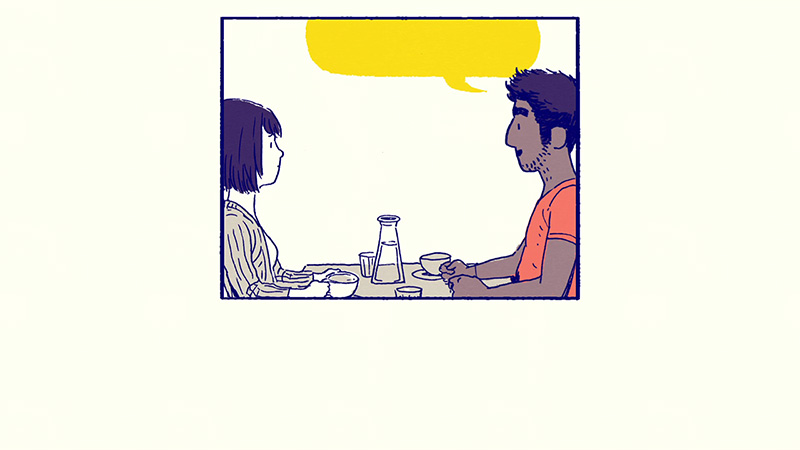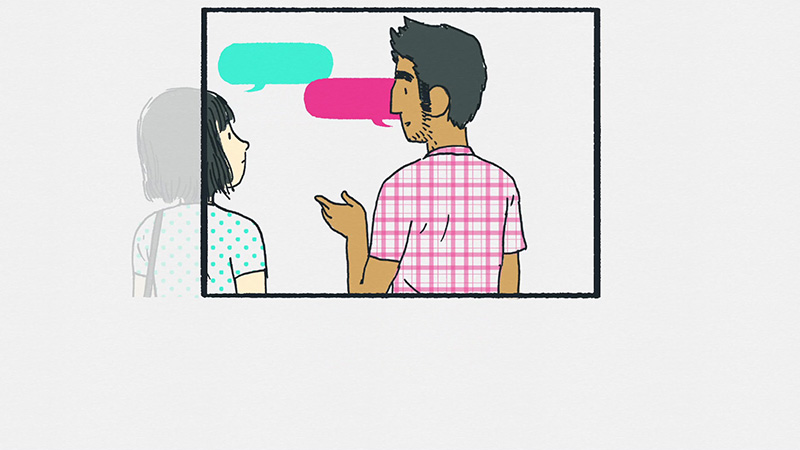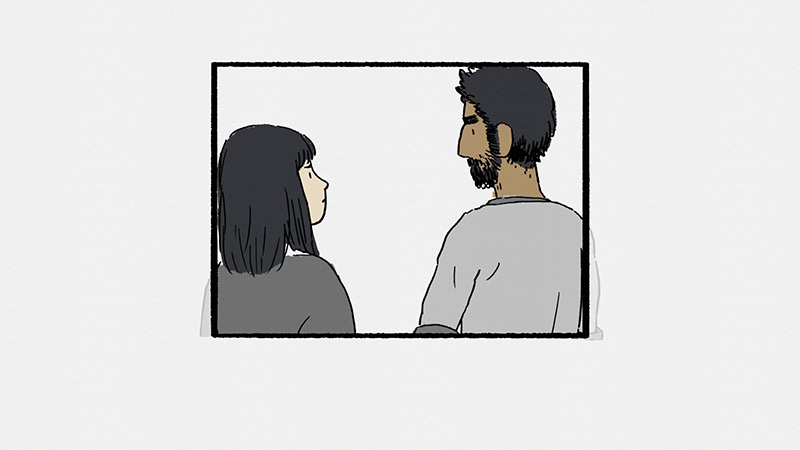Blogging From The Couch
PUBBLICATO: XX MESE 20XX
ULTIMO AGGIORNAMENTO: XX MESE 20XX
Introduction
DISCLAIMER: This article contains spoilers and is intended for those who have already played the title.
I bought Florence by chance, during a Steam sale session.
One of the seventeen thousand a year that there are. I don't remember which one.
I was looking for simple but impactful games, like philosophical narrative or surreal, maybe something experimental.
Needless to say, Florence wasn't really what I wanted, nor was I the type of visual novel in general, let alone a slice-of-life with a major romantic undertone.
However, the trailer fascinated me. The graphics were hand-drawn and the soundtrack was really pleasant and engaging.
I let myself be convinced to buy it, with the discounts it literally cost a couple of pennies.
Today I can say that I am really very happy to have bought it!
Florence turned out to be a great little game, a simple but brilliant bead in a sea of enormous colored stones with magical reflections.
Obviously it's not a best-seller, nor a masterpiece and that's fine. The world of indie games is beautiful especially for this: although it may seem (and probably is) a bit saturated in some of its corners, there is still room for small productions of this genre, which only want to tell a story that you can easily empathize with, without too many gameplay complications or too many mental blocks about originality at all costs.
Like visual novels, precisely.
If you want to know what I think of the game, you can read my review!
Beyond what the video game itself is, one of the things that still strikes me the most is the mechanism which the development studio has codified the tone of the dialogues with, in a video game… silent.
Imagine: you have to create a video game that tells the story of a young girl trapped in the monotony of her daily life, who suddenly falls in love with a handsome street musician and how the spark ignites a story that then fails, but without dialogues. You have to tell in particular -this part-, the evolution (not the before, not too much the after), the feeling, the whirlwind of emotions, the first clashes without using verbal communication.
But if there are no dialogues, no voices, no subtitles, if there are no words of any kind... how do you do it?
And here we come.
Mountains has developed a system that I found to be nothing short of brilliant in its undeniable and fantastic simplicity, although I admit that I have no idea if it's truly original. And this system makes Florence a game that, being silent, can be truly understood by anyone, regardless of the language spoken.
For me, it's a great example of universal non-verbal communication.
But let's get into the details.
What system are we talking about?
These are the (non) dialogue bubbles.
Normally in bubbles, like those in comics, we would have found words and sentences in a given language, to explain what the people involved are saying to each other and in what tone, regarding whatever the discussion is at that moment.
Here instead we have the antithesis: empty bubbles (after all the game is silent ...).
So how do I convey a heated or brusque tone? How do I make the player understand if the characters are calm or angry, or if they are changing mood beyond representing them with different expressions and body language?
Let's also keep in mind that the game has 2D graphics drawn by hand and mainly static, so no cutscenes or more expressive scenes in 3D.
The studio then came up with this three-factor trick: composing the bubbles with movable pieces and, depending on the situation, colouring them differently and altering the shape of the joints.
Now I will explain it better using screenshots directly, taken from each scene in which they appear.
First Chance

This chapter of the game introduces the mechanics of empty bubbles.
Questo è il primo appuntamento tra Florence e Krish.
Fino a questo punto il gioco ci ha dipinto Florence come timida ed un po’ introversa, di conseguenza non può che essere in imbarazzo ad uscire con un ragazzo che lei reputa evidentemente bello ed affascinante. Un ragazzo che oltretutto ha conosciuto in modo improvviso e un po’ rocambolesco.

At the beginning Florence has eight puzzle pieces, to communicate her embarrassment and awkwardness.
Simply put, Florence is having trouble with the social interactions she has to deal with and even more so because she's not neutral, she's interested in Krish and obviously doesn't want to look awkward.
Com’è facile vedere, la bubble di Florence è composta da molti pezzi (all’inizio otto disposti su due livelli) e da incastri tondeggianti.
E’ contenta di essere a questo appuntamento, ma come per tutte le persone tendenzialmente introverse o che non sono abituate, rompere il ghiaccio le richiede un grande investimento di risorse mentali ed energia. Il risultato è che in confronto a lui, più sciolto ed espansivo, è lenta a reagire.
Lentezza e difficoltà sono tradotte con il numero di pezzi: più sono, più il giocatore impiega a metterli a posto correttamente.
La scioltezza di Krish, invece, la vediamo subito: non appena completiamo il nostro puzzle, la sua bubble compare in pochi secondi, lasciandoci con un’altra bubble/puzzle da mettere a posto mezzo battito di ciglia dopo aver finito l’altra. Questo ci fa avvertire un po’ la pressione di Florence nel tenere il ritmo della conversazione senza sembrare socialmente a livello di un’ameba paglierina.
However, as the sequence progresses and we are shown how Florence, once she has gained confidence and come out of her shell a little, reveals herself to be a lively and cheerful girl.
Infatti, all’appuntamento successivo (che intuiamo per via dei vestiti, diversi da quelli dell’incontro precedente), la prima bubble di Florence ha già perso pezzi ed ora sono solo quattro su di un solo livello, con incastri sempre arrotondati.
Questo ci consente di risolvere il puzzle molto più in fretta del precedente e la velocità di risposta per Krish è meno ansiogena anche per noi.
La conversazione è, di fatto, più scorrevole.
The second and third and final bubbles have just three pieces.

The number of pieces gets smaller as Florence becomes more familiar with Krish
L’appuntamento seguente è quello che sancisce l’inizio della loro storia e per comunicarci che i due si sono ufficialmente innamorati, Florence ha bubble di un bel colore passionale e due soli pezzi.
La terza bubble della serie, ultima per questo ciclo, è di nuovo fatta sì di due soli pezzi, ma stavolta muovendone uno li muoviamo entrambi e completiamo il puzzle con una mossa unica.

At this point there are only two pieces and in the last interaction they move together
Second Chance

In questa scena viene introdotta una rappresentazione grafica delle emozioni
The event here is brief, but important nonetheless, as it illustrates the real reason why I consider this dynamic almost brillant.
Florence e Krish sono a fare la spesa e, per ragioni che non ci è dato conoscere, probabilmente in una sequenza di piccoli accadimenti in cui quasi tutti possiamo immedesimarci, finiscono a bisticciare.
Non sappiamo nemmeno se sia il primo grosso bisticcio che affrontano o se sia una situazione che si trascina già da qualche tempo e che magari accade per la prima volta in un luogo pubblico. Potrebbe anche essere il primo episodio che li vede trascendere oltre la breve discussione. Oppure è semplicemente è uno dei tanti che affrontano.
Even here, however, time has passed, Florence's hair is visibly longer (before it reached almost to her jaw line, now it is at least a few centimetres longer) and Krish also appears different.
Initially, everything works as we have already seen: we have the slightly perplexed Florence's blue bubbles, made up of three pieces with rounded joints, and the fuchsia Krish bubbles that complete themselves.

Inizialmente troviamo le cose come in precedenza: incastri rotondi
However, when she starts to get annoyed and Krish seems to get annoyed in return, Florence's bubble changes shape. It always remains blue and always has three pieces, but the joints become rectangular and angular, with 90° angles. The same thing for Krish's, which makes us understand that the issue isn't being resolved and both are firm in their positions/opinions.

L'inasprimento dei toni è reso dagli incastri rettangolari
A questo punto vediamo un altro cambiamento: gli incastri di Florence questa volta si presentano come piccoli cunei appuntiti.
E’ facile percepire come il suo tono a questo punto si stia facendo più aspro e quella che era nata probabilmente come un’incomprensione si stia trasformando in un bisticcio vero e proprio.
Anche in questo caso, lo stesso avviene per Krish.

The clash worsens further and becomes an argument: the puzzles become cuneiform
Note that the number of pieces is the same. Personally, I interpreted it as stability regarding the discussion, the misunderstanding isn't serious and has only influenced their mood, it's not damaging damaging their relationship.
In support of my thesis, we have Florence and Krish returning to the round insets in the immediately following scene, which in my opinion can be interpreted as a way of stopping and trying to clarify, lowering the tone from before.
Questo tentativo però non sembra dare i risultati sperati e pur con gli incastri che rimangono tondi, assistiamo ad una nuova dinamica: il bisticcio trascende i toni di nuovo e questa cosa ci viene segnalata con l’inclinazione dell’uno o dell’altro personaggio verso la controparte, una rappresentazione grafica del tentativo di prevaricare e di avere ragione.
Più si è lenti a risolvere il puzzle di Florence, meno bubble si completano, più Krish sarà inclinato verso di lei. E viceversa nel caso si sia sufficientemente rapidi.
A prima vista è facile avere l’impressione di un battibecco in cui si è finiti a rinfacciarsi cose che, magari, nemmeno c’entrano le cause che l’hanno scatenato.
For anyone, like me, not inclined to discussions that transcend being intense but cordial or where someone tries to physically impose themselves by invading someone else's personal space, it could also have a vague taste of anxiety. It really makes you want to eat Krish's head to tell him to take ten steps back and go take a cold shower, which maybe will pass (it doesn't matter if we don't know if it's Florence who's wrong or him, we play by looking at things through her eyes).

Tornano gli incastri tondi, ma viene introdotta l'inclinazione dei personaggi
Third Chance

In questa scena viene introdotta una rappresentazione grafica delle emozioni
This is the last time the dynamic occurs before the end of the game and shows us how the story between Florence and Krish ends. In fact, we could say that the argument is the straw that breaks the camel’s back and makes it explode like a supernova.
The couple is presented to us already in a state of great stress, their relationship is wearing away and even if we can't know how quickly, it's clear that its wearing away is progressive and does not regenerate.
Qui li troviamo intenti a mettere a posto i piatti, quando ad un tratto iniziano a discutere.
È facile intuire come sia passato ulteriore tempo: il loro aspetto è maturato, Florence ha i capelli più lunghi delle scene precedenti, Krish sembra molto più maturo e “adulto” nei tratti.
Sono anche spariti i colori. Tutto è grigio e freddo, loro compresi.
What is already extremely different is the color of Florence's bubble: RED.
Red is the color of alarm, danger, prohibitions and ANGER.
A color so strong that, in the absence of other surrounding colors, it emerges like a tsunami of anger.
They're neighbors, they're taking care of the house, but there's already a solid wall between them and they are hostile towards each other.
What's quite curious is that the joint is round.
As far as I'm concerned, I didn't interpret it as something positive, I attribute the rounded joints to habit and if that were really the case, it'd mean that their daily life now also includes arguing.
For most of the exchange the dynamics are similar to what we saw on the previous occasion. The insets become rectangular and then triangular, the color remains constant and so does the number of pieces.

Il rosso enfatizza ulteriormente l'evoluzione degli incastri e l'escalation emotiva
Only at the end do we stumble upon a new evolution of the mechanics, which manages to express even better the level of acrimony that has accumulated like poison in their relationship.
Here the bubbles have no more pieces. They are red balloons to drag into their place one after the other, a back-and-forth where we listen to each other less and less and end up barking in each other's faces without a solution of continuity.
With each replica of one or the other, three or four come out together and in rapid succession, but it's difficult to count them both because of the speed with which they appear and because of the lack of outlines that very quickly creates a cloud of crimson gall that just won't stop expanding.

Trascinare le bubble intere trasmette efficacemente il botta-e-risposta tra i due
We're faced with the evident negative climax of their relationship and the escalation is so dramatic and unstoppable that at this point we find them in tears of fury and frustration.
At the end of this sequence we've the final bang and the game will no longer offer us this dynamic.
A curious note is that in this last phase, the speed with which Krish responds slows down, as if he were unable to keep up with Florence's anger or as if she had learned to keep up with him and even surpass him. In other instances, however, it was difficult to keep up with him.
Summing up
In its simplicity and brevity, Florence proves to be a very interesting example of universal non-verbal communication: no matter what language the player speaks, his cultural, social or economic background, his educational qualifications or his inclinations, he will be perfectly able to understand everything without seeing a written word.
Even the reason for the progressive deterioration of the relationship between Florence and Krish is completely irrelevant, and, indeed, it lends itself to seeing whatever the player wants to see in it, from nothing serious to serious or toxic dynamics, from reasons with which he is not familiar to personal experiences through which to relate to the story.
Stories and experiences that, here too, are universal.
Was the substrate for their friction their different cultural backgrounds? Character differences? The stress due to the weight of their work and their ambitions? Was it Krish who was difficult or Florence?
We could ask ourselves hundreds of questions like this, but nothing would change us or how the story unfolds.
I personally recommend anyone who is a visual novel fan to give Florence a chance to experience this original mechanism and experience those moments of honest frustration first hand.


